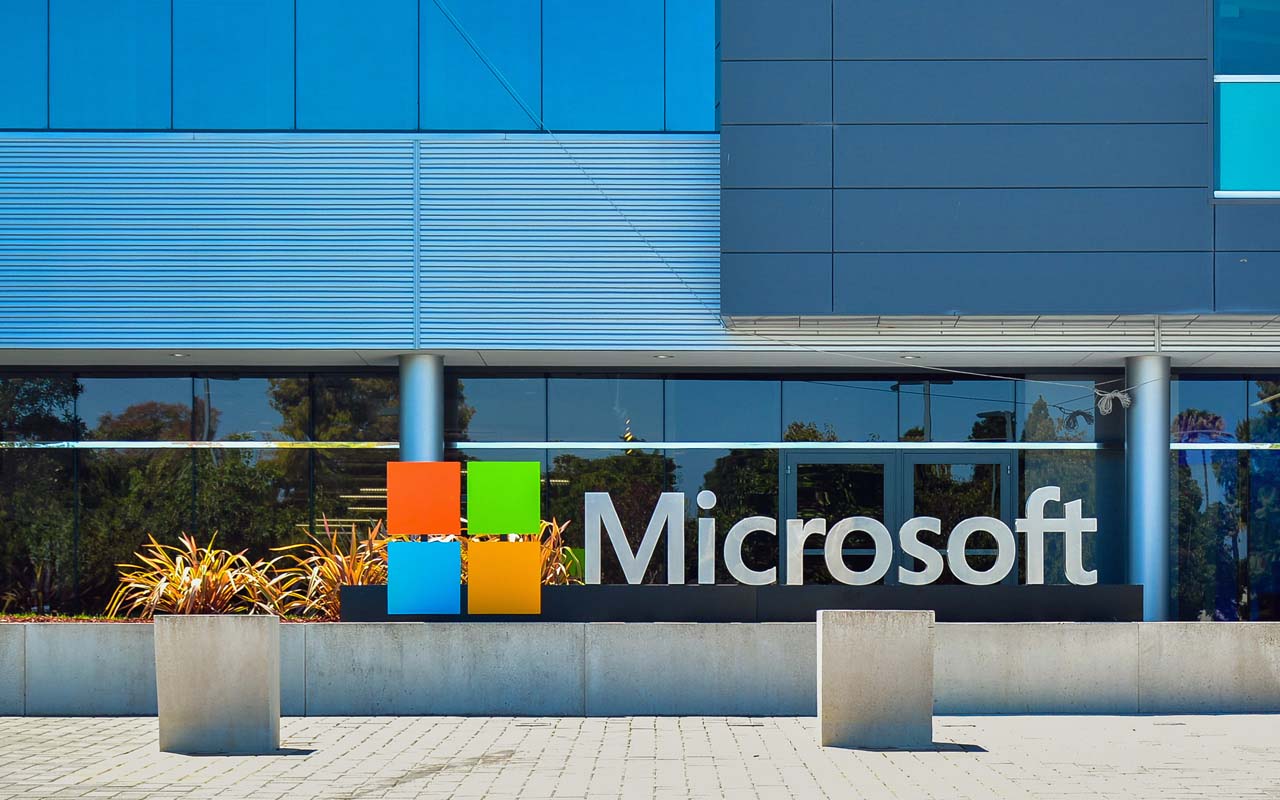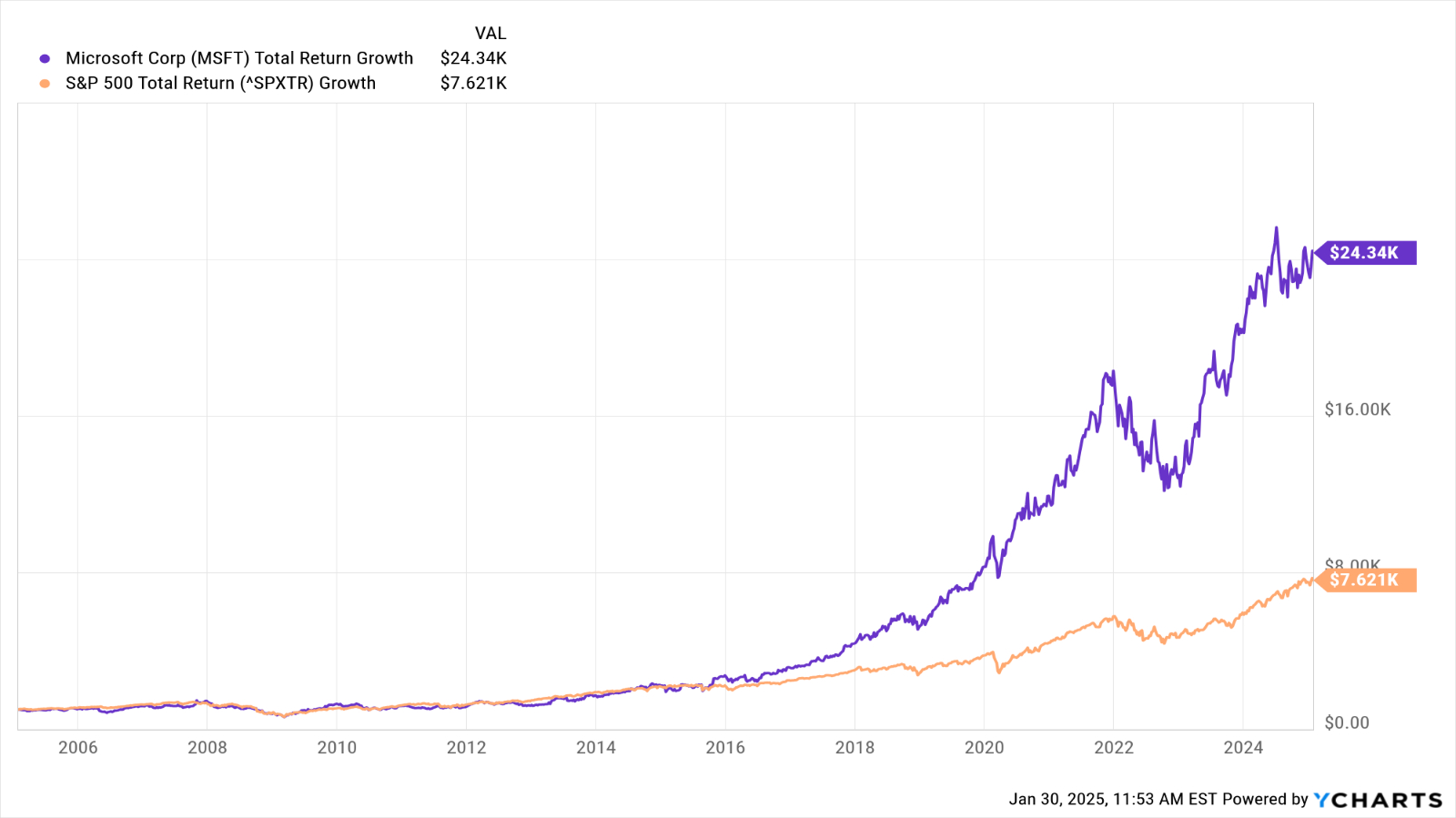If You'd Put $1,000 Into Microsoft Stock 20 Years Ago, Here's What You'd Have Today
Microsoft has been an astounding buy-and-hold bet for ages.



Not too long ago, Microsoft (MSFT) stock's glory days looked to be behind it as sales of desktop PCs slipped into a seemingly irreversible decline. Although the dot-com days of the 1990s minted many a "Microsoft millionaire," the aftermath of the tech bust led Microsoft stock to trade mostly sideways for more than a decade.
But the past 10-plus years have been nothing short of a renaissance for the tech giant. When CEO Satya Nadella ascended to the top job in 2014, he not only began instituting cultural changes, he transformed Microsoft's core strategy too. Cloud computing and subscription-based services were in; the days of selling software licenses via physical compact disks were passé.
That focus on enterprise customers and – most importantly – Microsoft's shift to selling cloud-based services such as Azure and Office 365 have been an astounding success. Today, Microsoft is a dominant player in cloud computing and a leader in generative artificial intelligence (AI) – and MSFT's returns prove it.

Sign up for Kiplinger’s Free E-Newsletters
Profit and prosper with the best of expert advice on investing, taxes, retirement, personal finance and more - straight to your e-mail.
Profit and prosper with the best of expert advice - straight to your e-mail.
Indeed, Microsoft stock has been so remunerative since Nadella took over that long-term investors might not even notice that dud decade-plus following the tech bust.
Between January 1990 and December 2020, shares in Microsoft, which joined the Dow in 1999 at the height of the dot-com boom, generated a total return of 57,730%. The S&P 500's total return came to a mere 1,950% over the same span.
Along the way, Microsoft generated $1.91 trillion in wealth for shareholders, good for an annualized dollar-weighted return of 19.2%, according to Hendrik Bessembinder, professor of finance at the W.P. Carey School of Business at Arizona State University.
Only Apple (AAPL) generated more wealth for shareholders over those three decades, making Microsoft one of the best stocks of the past 30 years, per Bessembinder's findings, which account for cash flows in and out of the business and other adjustments.
The bottom line on Microsoft stock

With Microsoft trading below its all-time highs, it seemed like a good time to remind folks what $1,000 invested in Microsoft 20 years ago would be worth today.
Have a look at the above chart and you see only market-matching returns until around 2015. Then MSFT takes off. Indeed, it took off so much that if you put a grand into Microsoft stock two decades ago, today it would be worth more than $24,000. That's good for an annualized total return (price change plus dividends) of 17.3%, according to data from YCharts.
The same amount invested in the S&P 500 20 years ago would theoretically be worth about $7,600 today, or 10.7% annualized.
But wait, there's more.
Over its entire life as a publicly traded company, Microsoft has generated an annualized total return of 25.7%. The S&P 500's total return comes to 10.6% annualized over the same span.
Happily for Microsoft bulls, analysts very much expect shares to continue their market-smashing ways.
Of the 56 analysts issuing opinions on Microsoft stock surveyed by S&P Global Market Intelligence, 38 call it a Strong Buy, 13 say Buy and five have it at Hold. That works out to a rare consensus recommendation of Strong Buy, making MSFT a top-rated Dow Jones stock. Indeed, at Strong Buy, Microsoft is one of analysts' top S&P 500 stocks to buy now.
Check out the stocks billionaires are buying or hedge funds' top blue chip stocks and you'll see that much of the putative smart money agrees with Wall Street's assessment.
More Stocks of the Past 20 Years
- If You'd Put $1,000 Into Nvidia Stock 20 Years Ago, Here's What You'd Have Today
- If You'd Put $1,000 Into Google Stock 20 Years Ago, Here's What You'd Have Today
- If You'd Put $1,000 Into Apple Stock 20 Years Ago, Here's What You'd Have Today
Get Kiplinger Today newsletter — free
Profit and prosper with the best of Kiplinger's advice on investing, taxes, retirement, personal finance and much more. Delivered daily. Enter your email in the box and click Sign Me Up.

Dan Burrows is Kiplinger's senior investing writer, having joined the august publication full time in 2016.
A long-time financial journalist, Dan is a veteran of MarketWatch, CBS MoneyWatch, SmartMoney, InvestorPlace, DailyFinance and other tier 1 national publications. He has written for The Wall Street Journal, Bloomberg and Consumer Reports and his stories have appeared in the New York Daily News, the San Jose Mercury News and Investor's Business Daily, among many other outlets. As a senior writer at AOL's DailyFinance, Dan reported market news from the floor of the New York Stock Exchange.
Once upon a time – before his days as a financial reporter and assistant financial editor at legendary fashion trade paper Women's Wear Daily – Dan worked for Spy magazine, scribbled away at Time Inc. and contributed to Maxim magazine back when lad mags were a thing. He's also written for Esquire magazine's Dubious Achievements Awards.
In his current role at Kiplinger, Dan writes about markets and macroeconomics.
Dan holds a bachelor's degree from Oberlin College and a master's degree from Columbia University.
Disclosure: Dan does not trade individual stocks or securities. He is eternally long the U.S equity market, primarily through tax-advantaged accounts.
-
 6 Stunning Waterfront Homes for Sale Around the US
6 Stunning Waterfront Homes for Sale Around the USFrom private peninsulas to lakes, bayous and beyond, Kiplinger's "Listed" series brings you another selection of dream homes for sale on the waterfront.
By Charlotte Gorbold Published
-
 Six Reasons to Disinherit Someone and How to Do It
Six Reasons to Disinherit Someone and How to Do ItWhether you're navigating a second marriage, dealing with an estranged relative or leaving your assets to charity, there are reasons to disinherit someone. Here's how.
By Donna LeValley Published
-
 Should You Still Wait Until 70 to Claim Social Security?
Should You Still Wait Until 70 to Claim Social Security?Delaying Social Security until age 70 will increase your benefits. But with shortages ahead, and talk of cuts, is there a case for claiming sooner?
By Evan T. Beach, CFP®, AWMA® Published
-
 Retirement Planning for Couples: How to Plan to Be So Happy Together
Retirement Planning for Couples: How to Plan to Be So Happy TogetherPlanning for retirement as a couple is a team sport that takes open communication, thoughtful planning and a solid financial strategy.
By Andrew Rosen, CFP®, CEP Published
-
 Market Turmoil: What History Tells Us About Current Volatility
Market Turmoil: What History Tells Us About Current VolatilityThis up-and-down uncertainty is nerve-racking, but a look back at previous downturns shows that the markets are resilient. Here's how to ride out the turmoil.
By Michael Aloi, CFP® Published
-
 Stock Market Today: Stocks Surge to Close a Volatile Week
Stock Market Today: Stocks Surge to Close a Volatile WeekIt was another day with a week's worth of both news and price action, but it ended on a strongly positive note.
By David Dittman Published
-
 Home Insurance: How to Cut Costs Without Losing Coverage
Home Insurance: How to Cut Costs Without Losing CoverageNatural disasters are causing home insurance premiums to soar, but don't risk dropping your coverage completely when there are ways to keep costs down.
By Jared Elson, Investment Adviser Published
-
 Markets Roller Coaster: Resist the Urge to Make Big Changes
Markets Roller Coaster: Resist the Urge to Make Big ChangesYou could do more harm than good if you react emotionally to volatility. Instead, consider tax-loss harvesting, Roth conversions and how to plan for next time.
By Frank J. Legan Published
-
 Why Homeowners Insurance Has Gotten So Very Expensive
Why Homeowners Insurance Has Gotten So Very ExpensiveThe home insurance industry is seeing more frequent and bigger claims because of weather, wildfires and other natural disasters.
By Karl Susman, CPCU, LUTCF, CIC, CSFP, CFS, CPIA, AAI-M, PLCS Published
-
 Stock Market Today: Uncertainty Proliferates: Dow Loses 1,014 Points
Stock Market Today: Uncertainty Proliferates: Dow Loses 1,014 PointsWeaker-than-expected consumer inflation data wasn't enough to stabilize sentiment during another volatile day for financial markets.
By David Dittman Published